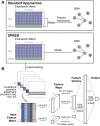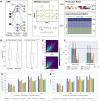SPREd: a simulation-supervised neural network tool for gene regulatory network reconstruction
- PMID: 38444538
- PMCID: PMC10913396
- DOI: 10.1093/bioadv/vbae011
SPREd: a simulation-supervised neural network tool for gene regulatory network reconstruction
Abstract
Summary: Reconstruction of gene regulatory networks (GRNs) from expression data is a significant open problem. Common approaches train a machine learning (ML) model to predict a gene's expression using transcription factors' (TFs') expression as features and designate important features/TFs as regulators of the gene. Here, we present an entirely different paradigm, where GRN edges are directly predicted by the ML model. The new approach, named "SPREd," is a simulation-supervised neural network for GRN inference. Its inputs comprise expression relationships (e.g. correlation, mutual information) between the target gene and each TF and between pairs of TFs. The output includes binary labels indicating whether each TF regulates the target gene. We train the neural network model using synthetic expression data generated by a biophysics-inspired simulation model that incorporates linear as well as non-linear TF-gene relationships and diverse GRN configurations. We show SPREd to outperform state-of-the-art GRN reconstruction tools GENIE3, ENNET, PORTIA, and TIGRESS on synthetic datasets with high co-expression among TFs, similar to that seen in real data. A key advantage of the new approach is its robustness to relatively small numbers of conditions (columns) in the expression matrix, which is a common problem faced by existing methods. Finally, we evaluate SPREd on real data sets in yeast that represent gold-standard benchmarks of GRN reconstruction and show it to perform significantly better than or comparably to existing methods. In addition to its high accuracy and speed, SPREd marks a first step toward incorporating biophysics principles of gene regulation into ML-based approaches to GRN reconstruction.
Availability and implementation: Data and code are available from https://github.com/iiiime/SPREd.
© The Author(s) 2024. Published by Oxford University Press.
Conflict of interest statement
None declared.
Figures




Update of
-
SPREd: A simulation-supervised neural network tool for gene regulatory network reconstruction.bioRxiv [Preprint]. 2023 Nov 13:2023.11.09.566399. doi: 10.1101/2023.11.09.566399. bioRxiv. 2023. Update in: Bioinform Adv. 2024 Jan 23;4(1):vbae011. doi: 10.1093/bioadv/vbae011. PMID: 38014297 Free PMC article. Updated. Preprint.
Similar articles
-
SPREd: A simulation-supervised neural network tool for gene regulatory network reconstruction.bioRxiv [Preprint]. 2023 Nov 13:2023.11.09.566399. doi: 10.1101/2023.11.09.566399. bioRxiv. 2023. Update in: Bioinform Adv. 2024 Jan 23;4(1):vbae011. doi: 10.1093/bioadv/vbae011. PMID: 38014297 Free PMC article. Updated. Preprint.
-
MICRAT: a novel algorithm for inferring gene regulatory networks using time series gene expression data.BMC Syst Biol. 2018 Dec 14;12(Suppl 7):115. doi: 10.1186/s12918-018-0635-1. BMC Syst Biol. 2018. PMID: 30547796 Free PMC article.
-
Inductive inference of gene regulatory network using supervised and semi-supervised graph neural networks.Comput Struct Biotechnol J. 2020 Nov 5;18:3335-3343. doi: 10.1016/j.csbj.2020.10.022. eCollection 2020. Comput Struct Biotechnol J. 2020. PMID: 33294129 Free PMC article.
-
Inference of plant gene regulatory networks using data-driven methods: A practical overview.Biochim Biophys Acta Gene Regul Mech. 2020 Jun;1863(6):194447. doi: 10.1016/j.bbagrm.2019.194447. Epub 2019 Oct 31. Biochim Biophys Acta Gene Regul Mech. 2020. PMID: 31678628 Review.
-
[Gene regulatory network of hepatocellular carcinoma: a review].Sheng Wu Gong Cheng Xue Bao. 2016 Oct 25;32(10):1322-1331. doi: 10.13345/j.cjb.160045. Sheng Wu Gong Cheng Xue Bao. 2016. PMID: 29027443 Review. Chinese.
Cited by
-
Biophysics-based protein language models for protein engineering.bioRxiv [Preprint]. 2025 Apr 24:2024.03.15.585128. doi: 10.1101/2024.03.15.585128. bioRxiv. 2025. PMID: 38559182 Free PMC article. Preprint.
-
CRISPR-GEM: A Novel Machine Learning Model for CRISPR Genetic Target Discovery and Evaluation.ACS Synth Biol. 2024 Oct 18;13(10):3413-3429. doi: 10.1021/acssynbio.4c00473. Epub 2024 Oct 7. ACS Synth Biol. 2024. PMID: 39375864 Free PMC article.
-
CRISPR-GEM: A Novel Machine Learning Model for CRISPR Genetic Target Discovery and Evaluation.bioRxiv [Preprint]. 2024 Jul 3:2024.07.01.601587. doi: 10.1101/2024.07.01.601587. bioRxiv. 2024. Update in: ACS Synth Biol. 2024 Oct 18;13(10):3413-3429. doi: 10.1021/acssynbio.4c00473. PMID: 39005295 Free PMC article. Updated. Preprint.
References
-
- Box GE, Cox DR.. An analysis of transformations. J R Stat Soc Ser B Stat Methodol 1964;26:211–43.
Grants and funding
LinkOut - more resources
Full Text Sources
Miscellaneous

